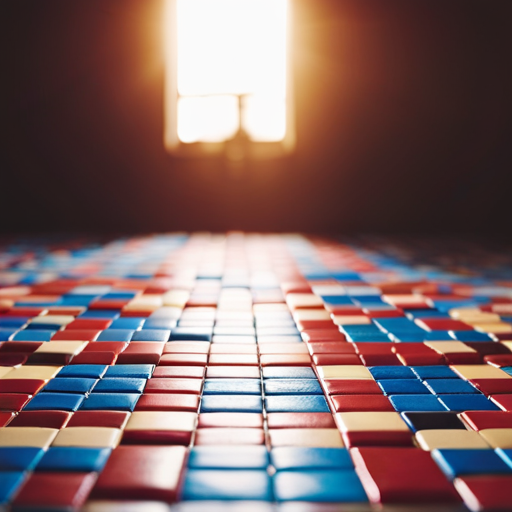The Art of Mixing and Matching Floor Tiles

Mastering the art of mixing and matching floor tiles is a multifaceted endeavor that requires a keen eye for color, shape, and texture. This innovative approach to flooring design offers a myriad of possibilities, from creating visual interest with varying shapes to incorporating depth and dimension through texture.
In this comprehensive guide, we will explore the techniques and strategies for seamlessly blending different tile materials, colors, and patterns to create stunning and unique floor designs.
Understanding Different Tile Materials
While the aesthetic appeal of floor tiles is important, understanding the different materials used in their construction is essential for making informed design and installation decisions. Tile materials vary greatly in terms of durability, cost, installation challenges, and maintenance requirements.
For instance, ceramic and porcelain tiles are known for their durability and low maintenance, making them suitable for high-traffic areas, but they can be more expensive than other options. On the other hand, natural stone tiles offer a unique, luxurious look, but they may require more frequent maintenance and can be prone to staining. Vinyl tiles, while cost-effective and easy to install, may not be as durable as ceramic or porcelain tiles.
Considering these factors is crucial for achieving a balance between aesthetics, practicality, and budget. By understanding the characteristics of different tile materials, homeowners and designers can make informed choices that align with their specific needs and preferences.
Transitioning into the subsequent section about ‘exploring color combinations and patterns’, the selection of tile materials sets the foundation for creating visually stunning and functional flooring designs.
Exploring Color Combinations and Patterns
As we explore the realm of color combinations and patterns, it’s essential to consider the impact of bold pattern contrasts and how they can infuse energy into a space.
Harmonizing with color opens up a world of possibilities, allowing for a cohesive and balanced aesthetic that ties the room together.
Bold Pattern Contrasts
Bold pattern contrasts can create visually striking floor designs by combining vibrant colors and intricate patterns. When it comes to bold pattern contrasts, the key is to find a balance between complementary and contrasting elements. Here are three essential tips for creating captivating floor designs:
-
Color Harmony: Pair bold colors with neutral tones to create a balanced yet eye-catching look.
-
Mixing Geometric and Organic Patterns: Combining geometric tiles with organic patterns can add depth and visual interest to the space.
-
Layering Patterns: Experiment with layering different patterns to create a dynamic and lively floor design.
By incorporating these tips, you can achieve a floor that is both visually captivating and harmoniously balanced.
Transitioning into the subsequent section, let’s now explore how to harmonize bold patterns with color choices to create cohesive and inviting spaces.
Harmonizing With Color
To achieve a harmonious blend of color combinations and patterns, one must carefully consider the interplay between hues and designs in the context of floor tile mixing and matching. Color matching is a crucial element in creating a cohesive and visually appealing space.
When harmonizing with color, it’s essential to pay attention to the undertones of each hue to ensure they complement rather than clash. Utilizing a color wheel can be helpful in identifying complementary, analogous, or monochromatic color schemes for tile placement.
Additionally, exploring patterns such as geometric, floral, or abstract designs can add depth and interest to the overall aesthetic.
Creating Visual Interest
When harmonizing with color, it is essential to carefully consider how different color combinations and patterns can be used to create visual interest in the context of mixing and matching floor tiles. Unique combinations of colors and patterns can significantly enhance the visual impact of a space, adding depth and personality to the design.
Here are some innovative ways to achieve this:
- Contrasting Colors: Experiment with contrasting colors to create a bold and dynamic look.
- Geometric Patterns: Incorporate geometric patterns to add a modern and artistic touch to the flooring design.
- Tonal Variations: Utilize tonal variations within the same color family to create a subtle yet visually stimulating effect.
Mixing Shapes and Sizes for Visual Interest
Mixing shapes and sizes of floor tiles can add depth and visual intrigue to any space. By incorporating varied shapes, such as hexagons, diamonds, or triangles, you can create a dynamic and eye-catching design.
Additionally, mixing different tile sizes, like large format tiles with smaller mosaic tiles, can bring impact and a sense of movement to the overall aesthetic.
Varied Shapes Create Intrigue
By incorporating varied shapes and sizes of floor tiles, an intriguing visual interest can be achieved in any space. Geometric shapes offer a modern and dynamic aesthetic, adding depth and dimension to the flooring. The design possibilities are endless, allowing for the creation of captivating patterns and asymmetrical layouts that capture attention and create a unique atmosphere.
Mixing different shapes such as triangles, hexagons, and rectangles can result in visually stimulating floors that become a focal point in any room. This approach not only adds a sense of creativity to the space but also allows for personalized and one-of-a-kind designs that reflect individual style and taste.
Transitioning into the subsequent section about mixing sizes for impact, this creative approach to tiling can significantly elevate the overall look and feel of a space.
Mix Sizes for Impact
One can achieve visual interest and impact by strategically mixing different sizes and shapes of floor tiles, creating an engaging and dynamic design. Size variation impact plays a pivotal role in elevating the overall aesthetic of a space.
By incorporating a mix of large-format tiles with smaller ones, a visual impact is achieved, drawing the eye to various focal points within the layout. This approach adds depth and dimension to the design, creating a dynamic visual experience for the observer.
Furthermore, the layout impact of mixing sizes for impact cannot be overstated. It allows for the creation of visually stimulating patterns and arrangements, transforming ordinary floors into captivating works of art. The juxtaposition of different sizes adds an element of surprise and creativity to the design, making it truly unique and visually striking.
Incorporating Texture for Depth and Dimension
Utilizing various textures in floor tiles adds depth and dimension to a space, enhancing the overall aesthetic and visual interest. Incorporating texture play can create a dynamic visual impact, making the floor a focal point of the room.
To achieve this, consider the following:
-
Natural Stone: Introducing natural stone tiles alongside smoother ceramic or porcelain tiles can create a visually striking contrast. The rough, organic texture of natural stone juxtaposed with the sleek surface of ceramic or porcelain adds depth and complexity to the floor design.
-
Wood Grain: Incorporating wood grain tiles can infuse warmth and a tactile element into the space. The natural variation in wood grain patterns adds visual depth, while the textured surface provides an interesting tactile experience.
-
Mosaic Patterns: Utilizing mosaic tiles with varying textures can create a visually stimulating effect. Mixing glossy, matte, and textured mosaic pieces within the flooring design adds dimension and visual intrigue.
Incorporating contrasting materials and textures not only enhances the visual depth of the floor but also contributes to the overall ambiance of the room, creating a space that is rich in character and style.
Creating Focal Points With Accent Tiles
To further enhance the visual impact of mixed floor tiles, strategically placing accent tiles can create compelling focal points within the overall flooring design.
Designing focal points with accent tiles involves more than just randomly scattering them across the floor. Instead, it requires a thoughtful approach to accent tile placement.
One effective method is to use accent tiles to create a focal point at key areas such as entryways, around a fireplace, or in the center of a room. This can draw the eye and add visual interest to the space.
Another approach is to use accent tiles to define specific zones within an open floor plan, such as delineating the dining area in a kitchen or creating a border around a seating area in a living room.
The key is to use accent tiles purposefully to guide the gaze and add a touch of personality to the overall design.
As we delve into designing focal points with accent tiles, it’s essential to consider how to seamlessly transition between different tile styles to achieve a cohesive and harmonious look throughout the space.
Tips for Seamless Transitions Between Tile Styles
Strategically placing accent tiles to create focal points within the overall flooring design not only enhances visual impact but also requires seamless transitions between different tile styles to achieve a cohesive and harmonious look throughout the space.
Achieving seamless transitions between tile styles can be a challenging task, but with the right approach, it can elevate the entire aesthetic of a room. Here are some tips to ensure a smooth and flawless transition between different tile styles:
-
Consistent Grout Color: Using the same grout color across different tile styles helps create a seamless transition and ensures that the focus remains on the tiles themselves rather than the divisions between them.
-
Gradual Blend: Gradually transitioning from one tile style to another by incorporating a border or gradually mixing the tiles can create a visually appealing and seamless effect.
-
Pattern Experimentation: Experimenting with different patterns and layouts can help seamlessly integrate various tile styles, allowing for a cohesive and dynamic flooring design.
Maintenance and Care for Mixed Tile Floors
When maintaining and caring for mixed tile floors, it is essential to follow proper cleaning and maintenance practices to preserve the integrity and aesthetic appeal of the diverse tile styles.
Cleaning techniques for mixed tile floors depend on the materials used. Porcelain and ceramic tiles are relatively low-maintenance, requiring regular sweeping and occasional mopping with a mild detergent.
Natural stone tiles, on the other hand, demand specialized cleaners to avoid damage. Additionally, the sealing process is crucial for natural stone to prevent staining and water damage.
Preventing grout discoloration is also vital for maintaining the visual appeal of mixed tile floors. Regularly cleaning grout lines with a pH-neutral cleaner and applying a grout sealer can help prevent discoloration and deterioration.
Proper maintenance of grout includes promptly repairing any cracks or gaps to prevent moisture from seeping beneath the tiles, which can lead to more substantial problems.
Frequently Asked Questions
Can I Mix and Match Different Types of Tiles, Such as Ceramic and Natural Stone, in the Same Room?
Mixing materials such as natural stone and ceramic tiles in the same room can create a visually stunning and unique floor. Careful consideration of tile patterns, colors, and textures will ensure a cohesive and aesthetically pleasing result.
What Are Some Creative Ways to Incorporate Metallic or Glass Accent Tiles Into a Floor Design?
Incorporating color and adding patterns in floor designs can be creatively enhanced with metallic or glass accent tiles. These elements bring a touch of glamour and modernity, transforming the space into a trendy and visually captivating area.
How Can I Ensure a Smooth Transition Between Different Tile Styles, Especially in High-Traffic Areas?
In high-traffic areas, smooth transitions between different tile styles are crucial. Utilize color combinations and transition techniques to create a cohesive look. Consider using complementary or contrasting colors to delineate distinct zones while maintaining visual flow.
Are There Any Special Maintenance Considerations for Floors With Mixed Tile Materials and Textures?
Special cleaning and maintenance are essential for mixed material and textured floors. Regular sealing prevents dirt buildup and protects the different tile types. Consult with a professional to determine the best cleaning methods for your specific floor.
What Are Some Unexpected Ways to Use Tile Shapes and Sizes to Create Visual Interest in a Room?
To create visual interest in a room, consider using unexpected tile shapes and sizes. Play with color combinations, texture contrast, and geometric patterns to add depth and dimension. This creative approach can transform any space into a trendy and innovative design.
Conclusion
In conclusion, the art of mixing and matching floor tiles offers endless possibilities for creating visually stunning and unique spaces. By understanding different tile materials, exploring color combinations, mixing shapes and sizes, and incorporating texture and focal points, you can achieve a floor that is both stylish and functional.
With seamless transitions and proper maintenance, mixed tile floors can truly transform a room. How will you use these techniques to elevate your own space?

Rubin Everest, a seasoned expert in the world of flooring, brings a wealth of knowledge and passion to the surface. As the mind behind ebbow.com, Rubin is dedicated to sharing insights on the latest trends, innovative solutions, and expert advice in the realm of flooring. Whether you’re seeking practical tips for installation or design inspiration, Rubin Everest is your go-to source for all things flooring-related, making your journey to the perfect floor an informed and enjoyable experience.





